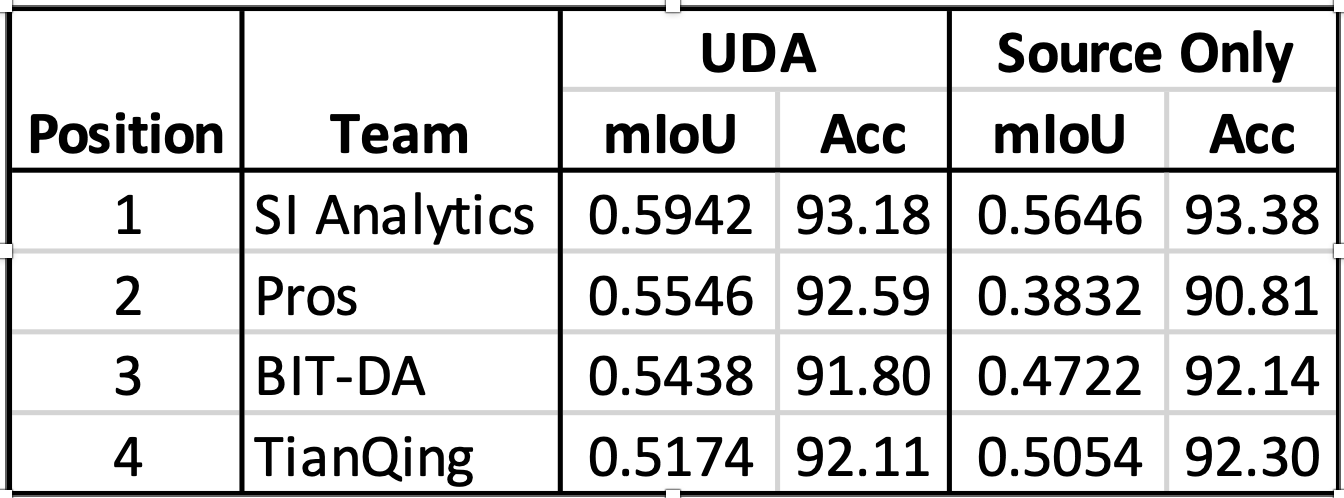A novel one-stage adaptation framework that highlights the semantic concepts of individual pixel to promote learning of class-discriminative and class-balanced pixel embedding space across domains.
We use the provided dataset/pre-trained checkpoints without any additional datasets/checkpoints
The pre-trained folder should include pretrained/mit_b5.pth
The data folder should be structured as follows:
├── data/
│ ├── zerowaste-f/
| | ├── train/
| | | ├── data/
| | | ├── sem_seg/
| | ├── val/
| | | ├── data/
| | | ├── sem_seg/
| | ├── test/
| | | ├── data/
| | | ├── sem_seg/
│ ├── zerowaste-v2-splits/
| | ├── train/
| | | ├── data/
| | ├── val/
| | | ├── data/
| | ├── test/
| | | ├── data/
│ └──
To train the model with a desired configuration, and produce final predictions in the original label mapping (0 = 'background', 1 = 'rigid_plastic', 2 = 'cardboard', 3 = 'metal', 4 = 'soft_plastic'), use the following script:
# STEP 1: Training
# To run an experiment, first set the parameters in `experiments.py` and take the exp id here
# The working directory is set to `./work_dirs_test`. Change it in run_experiments.py if you would like to.
## source only
python run_experiments.py --exp 0
## SePiCo, 3 random runs
python run_experiments.py --exp 1
# STEP 2: Evaluate and do palette
# This step evaluates the model and outputs corresponding test set labels (zero v2 val/test set)
# Gets visuals here
## source only
python -m tools.test CFG_PATH MODEL_PATH --show-dir ./PATH_TO_SHOW/exp0/palette --opacity 1
## ensemble sepico
python -m tools.ensemble_test CFG1_PATH CFG2_PATH CFG3_PATH --checkpoint MODEL1_PATH MODEL2_PATH MODEL3_PATH --show-dir ./PATH_TO_SHOW/exp1/palette --opacity 1 --ensemble-policy average_policy
# STEP 3: Converting for submission
# This step converts visual labels to train id labels to prepare for submission
python -m tools.convert_visuals_to_labels ./PATH_TO_SHOW/exp0/palette ./PATH_TO_SHOW/exp0/source_only
python -m tools.convert_visuals_to_labels ./PATH_TO_SHOW/exp1/palette ./PATH_TO_SHOW/exp1/uda
# STEP 4: Packing and zipping
zip -q -r sepico_v1_to_v2.zip ./PATH_TO_SHOW/exp1/uda ./PATH_TO_SHOW/exp0/source_onlyThe baseline results on the test and validation sets of ZeroWaste V2 are as follows:
| Experiment | test mIoU | test Acc | val mIoU | val Acc | #params |
|---|---|---|---|---|---|
| SegFormer V1 | 47.22 | 92.14 | 46.0 | 88.09 | 84.6 M |
| SePiCo V1->V2 | 54.38 | 91.80 | 54.0 | 87.57 | 85.55M |
We conducted all experiments on a single NVIDIA A100-SXM4-80GB, the training process costs about 14 hours (per run) and test process costs about 6 minutes (ensemble 3 runs).
@article{xie2022sepico,
title={SePiCo: Semantic-Guided Pixel Contrast for Domain Adaptive Semantic Segmentation},
author={Xie, Binhui and Li, Shuang and Li, Mingjia and Liu, Chi Harold and Huang, Gao and Wang, Guoren},
journal={arXiv preprint arXiv:2204.08808},
year={2022}
}


